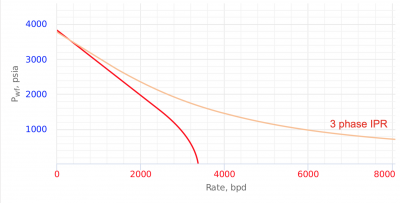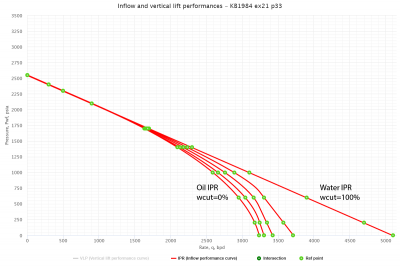3 Phase IPR
Contents
Three-phase Inflow Performance Relationship

3 Phase IPR is an IPR curve calculated on the basis of total barrels of produced fluid, including gas.
3 Phase IPR curve is used in Pump Design software for pump sizing.
Math and Physics
The volume of 1 stb of liquid plus associated gas (volume factor) at any pressure and temperature is given by[1]:
The total volume of produced fluid rate (liquid plus gas) at any conditions of pressure and temperature:
 is calculated as usual using:
is calculated as usual using:
- Vogel's IPR equation
- Composite IPR equation
3 Phase IPR calculation example

Following the well #1 example given by Brown[1]on Figure 5.8, page 191:
Given:
 = 2550 psi
= 2550 psi = 2100 psi
= 2100 psi
Test data:
 = 2300 psi
= 2300 psi = 500 b/d
= 500 b/d
Calculate:
Determine the 3 Phase IPR curves for Fw=0, 0.25, 0.5, 0.75, and 1.
Solution:
The problem was run through PQplot software for different values of watercut.
Result 3 Phase IPR curves are shown on Fig.1. Points indicate results obtained by Brown [1].
The PQplot model from this example is available online by the following link: 3 Phase IPR calculation example
Nomenclature
 = calculation variables
= calculation variables = oil fraction, fraction
= oil fraction, fraction = water fraction, fraction
= water fraction, fraction = productivity index, stb/d/psia
= productivity index, stb/d/psia = pressure, psia
= pressure, psia = flowing rate, stb/d
= flowing rate, stb/d
Subscripts
- b = at bubble point
- max = maximum
- o = oil
- r = reservoir
- t = total
- wf = well flowing bottomhole pressure
- wfG = well flowing bottomhole pressure at point G


